Vision Jet
Vision Jet
The Vision Jet, originally developed by Cirrus Aircraft, is a single-engine jet aircraft. This jet caters to the personal and business aviation market. The Vision Jet, formally known as the Cirrus SF50, is recognized for its distinctive design and advanced features.
Development and Design
The Vision Jet was developed to fill a unique niche. It targets pilots who want to transition from piston-powered planes. The development began in earnest in the early 2000s. By 2008, the prototype made its first flight.
The aircraft features a V-tail. This design choice reduces weight and complexity. The engine is mounted above the rear fuselage. This placement enhances cabin space and reduces cabin noise.
Flying the Vision Jet
The cockpit is designed with simplicity in mind. The Cirrus Perspective Touch by Garmin avionics system is easy to use. It features touchscreen controls that reduce pilot workload. The single-engine jet is powered by a Williams FJ33-5A turbofan engine. This engine delivers 1,800 pounds of thrust.
The Vision Jet has a maximum range of approximately 1,200 nautical miles. It can reach a cruising speed of 311 knots. The jet has a service ceiling of 31,000 feet.
Safety Features
The Vision Jet prioritizes safety. It includes the Cirrus Airframe Parachute System (CAPS). CAPS is a whole-airframe parachute system. In emergencies, the pilot can deploy the parachute to bring the aircraft down safely.
The jet also has an advanced stability augmentation system. This system helps maintain control during flight. The autopilot includes a Level Button which instantly recovers the aircraft to a level flight attitude if necessary.
Cabin Comfort
Inside the Vision Jet, the cabin offers ample space for up to five adults. Two child-sized seats can be added. The design focuses on modern comfort. Large windows provide excellent visibility. Passengers can enjoy natural light throughout the flight.
The seats are made of high-quality materials. The arrangement can be customized to meet different needs. Whether for business or leisure, the cabin can be tailored to fit.
Market Impact
Since its introduction, the Vision Jet has made a significant impact. It won the 2017 Collier Trophy, which recognizes outstanding achievements in aeronautics. The jet has been well received in the personal aviation sector. Its blend of performance, safety, and luxury appeals to pilots and passengers alike.
Operating Costs
The Vision Jet offers competitive operating costs for a jet. The single-engine design is more fuel-efficient. Maintenance requirements are streamlined. Pilots transitioning from piston aircraft find the costs manageable.
The Vision Jet’s fuel consumption is approximately 55 gallons per hour. This efficiency contributes to lower overall operational costs compared to other jets.
Owner Experience
Vision Jet owners often praise its simplicity and functionality. The aircraft is designed to be owner-operated. Pilots appreciate the ease of flying and advanced avionics. The Vision Jet allows for direct point-to-point travel. This flexibility is a significant advantage over commercial travel.
Many owners highlight the enhanced safety features as a primary reason for their choice. The CAPS system provides peace of mind during flight. The overall experience is one of convenience and confidence.
Training and Support
Pilots transitioning to the Vision Jet undergo comprehensive training. Cirrus offers a tailored training program. The program includes ground school and flight training. Simulation training is also available. This approach ensures pilots are well-prepared to handle the jet.
Cirrus provides ongoing support to Vision Jet owners. This support includes maintenance services and updates. The company has an extensive network of service centers. This network ensures that owners have access to necessary resources.
Environmental Considerations
The Vision Jet is relatively efficient in terms of emissions. The single-engine design contributes to a smaller carbon footprint. Advanced avionics optimize flight paths, reducing fuel consumption. The aircraft incorporates recyclable materials in its construction.
Cirrus continues to explore ways to improve environmental performance. The Vision Jet represents a step towards more sustainable aviation practices.



Subscribe for Updates
Get the latest articles delivered to your inbox.
We respect your privacy. Unsubscribe anytime.